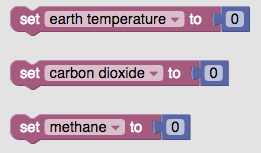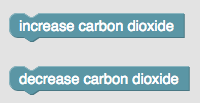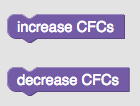
Start block marks the beginning of your code

End block marks the end of your code
Note: You should only have one start block and one end block.

Start block marks the beginning of your code

End block marks the end of your code
Note: You should only have one start block and one end block.

Variable setup defines specific variables for the greenhouse gas simulation for you. Notice, the values of these variables are all preset to zero. This is something you should change.
Note that the puzzle piece shape of the value block matches the needed inputs for the comparison and variable setup blocks.

If statement checks whether something input on the right side is true. If this input is true, statements included in the do section will run. If not, it will continue to whatever is attached to the bottom.

Repeat while checks whether something input on the right side is true. If this input is true, statements included in the do section repeat run until this input becomes false.

Value allows you to input the value of something that can then be used as input to set a variable or compare to another value.

Comparison allows you to compare two values. The middle is a drop down menu that allows you to check whether values are equal, not equal, less than, less than or equal to, greater than, or greater than or equal to.

Create variable allows you to define your own variable that you want to include. You can then use the set and change by blocks on these variables.

Increase and decrease methane blocks allow you to change the relative amount of methane (represented by yellow pixels) that show up in the graphic.

Increase and decrease carbon dioxide blocks allow you to change the relative amount of carbon dioxide (represented by blue pixels) that show up in the graphic.

Increase and decrease methane blocks allow you to change the relative amount of CFCs in the graphic. Since CFCs contribute to ozone layer thinning, pixels will disappear from the graphic if CFCs increase and pixels will reform in the graphic if CFCs decrease.

Ice melts and ice forms blocks allow you to change the relative amount of ice to water. When too much ice melts, the landmasses will cover up on the graphic. When too much ice forms, the entire planet could be covered in ice.
Note: These blocks do not change the values of different variables. They only reflect the changes in variable values through changes in the Earth and atmosphere graphic.